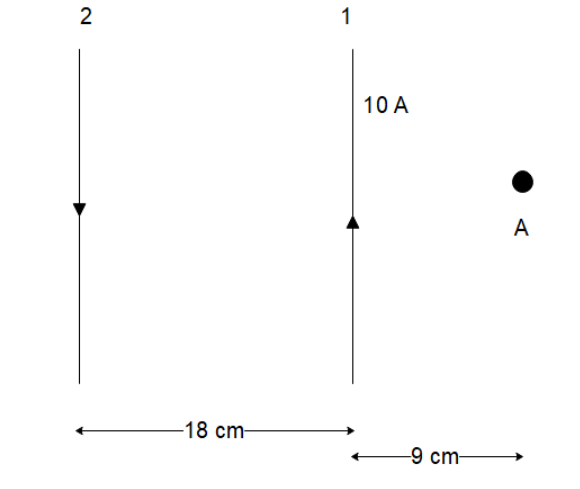
In figure two parallel infinitely long current-carrying wires are shown. If the resultant magnetic field at point A is zero, then determine current ${I_1}$.

A) 50A
B) 15A
C) 30A
D) 25A
Answer
218.1k+ views
Hint: In this solution, we will first determine the magnetic field of the current-carrying cables as a function of the distance of the point from the cable and then we will use the formula to determine the value of the current in the left wire.
Formula used: In this question, we will use the following formula
$B = \dfrac{{{\mu _o}I}}{{2\pi R}}$ where $B$ is the magnetic field generated by an infinite current-carrying wire at a point that is distance $R$ from it.
Complete step by step answer:
The direction of the magnetic field formed by a current-carrying wire can be determined by the right-hand rule. If we place our thumb in the direction of the current, we can determine the direction of the magnetic field as the direction our fingers point in.
For the cable on the left side, the magnetic field will be coming out of the page in the region on the right side of the two cables.
For the cable on the right side, the magnetic field will be going into the page in the region on the right side of the two cables.
So, we can expect the magnetic field in the region on the right side of the two cables to oppose each other.
The distance of the point from the first wire is 9 cm while the distance of the point from the second wire is $18 + 9 = 27\,cm$.
Since the magnetic field at point A is zero, we can say that the two magnetic fields in the opposite direction cancel each other out. So, we can write
$\dfrac{{{\mu _o}{I_1}}}{{2\pi {R_1}}} = \dfrac{{{\mu _o}{I_2}}}{{2\pi {R_2}}}$
Which give us
$\dfrac{{{I_1}}}{{{R_1}}} = \dfrac{{{I_2}}}{{{R_2}}}$
And hence
${I_1} = \dfrac{{{I_2}{R_2}}}{{{R_1}}}$
$ \Rightarrow {I_1} = \dfrac{{27 \times 10}}{3}$
Hence the current in the first cable is
${I_1} = 30\,A$ which corresponds to option (C).
Note: We must be very careful in determining the direction of the magnetic field while using the right-hand rule since the direction of the magnetic field also depends on which side of a cable we are calculating the magnetic field on. While there is no such thing as an infinite cable practically if the point we are measuring the magnetic field is too close to the wire, we can consider the wire to be infinitely long.
Formula used: In this question, we will use the following formula
$B = \dfrac{{{\mu _o}I}}{{2\pi R}}$ where $B$ is the magnetic field generated by an infinite current-carrying wire at a point that is distance $R$ from it.
Complete step by step answer:
The direction of the magnetic field formed by a current-carrying wire can be determined by the right-hand rule. If we place our thumb in the direction of the current, we can determine the direction of the magnetic field as the direction our fingers point in.
For the cable on the left side, the magnetic field will be coming out of the page in the region on the right side of the two cables.
For the cable on the right side, the magnetic field will be going into the page in the region on the right side of the two cables.
So, we can expect the magnetic field in the region on the right side of the two cables to oppose each other.
The distance of the point from the first wire is 9 cm while the distance of the point from the second wire is $18 + 9 = 27\,cm$.
Since the magnetic field at point A is zero, we can say that the two magnetic fields in the opposite direction cancel each other out. So, we can write
$\dfrac{{{\mu _o}{I_1}}}{{2\pi {R_1}}} = \dfrac{{{\mu _o}{I_2}}}{{2\pi {R_2}}}$
Which give us
$\dfrac{{{I_1}}}{{{R_1}}} = \dfrac{{{I_2}}}{{{R_2}}}$
And hence
${I_1} = \dfrac{{{I_2}{R_2}}}{{{R_1}}}$
$ \Rightarrow {I_1} = \dfrac{{27 \times 10}}{3}$
Hence the current in the first cable is
${I_1} = 30\,A$ which corresponds to option (C).
Note: We must be very careful in determining the direction of the magnetic field while using the right-hand rule since the direction of the magnetic field also depends on which side of a cable we are calculating the magnetic field on. While there is no such thing as an infinite cable practically if the point we are measuring the magnetic field is too close to the wire, we can consider the wire to be infinitely long.
Recently Updated Pages
Young’s Double Slit Experiment Derivation Explained

Wheatstone Bridge Explained: Working, Formula & Uses

Chemical Properties of Hydrogen - Important Concepts for JEE Exam Preparation

JEE General Topics in Chemistry Important Concepts and Tips

JEE Atomic Structure and Chemical Bonding important Concepts and Tips

JEE Amino Acids and Peptides Important Concepts and Tips for Exam Preparation

Trending doubts
JEE Main 2026: Application Form Open, Exam Dates, Syllabus, Eligibility & Question Papers

Derivation of Equation of Trajectory Explained for Students

Hybridisation in Chemistry – Concept, Types & Applications

Understanding the Angle of Deviation in a Prism

Understanding Collisions: Types and Examples for Students

Understanding Atomic Structure for Beginners

Other Pages
JEE Advanced Marks vs Ranks 2025: Understanding Category-wise Qualifying Marks and Previous Year Cut-offs

How to Convert a Galvanometer into an Ammeter or Voltmeter

Understanding Centrifugal Force in Physics

Ideal and Non-Ideal Solutions Explained for Class 12 Chemistry

Degree of Dissociation: Meaning, Formula, Calculation & Uses

Understanding Electromagnetic Waves and Their Importance




